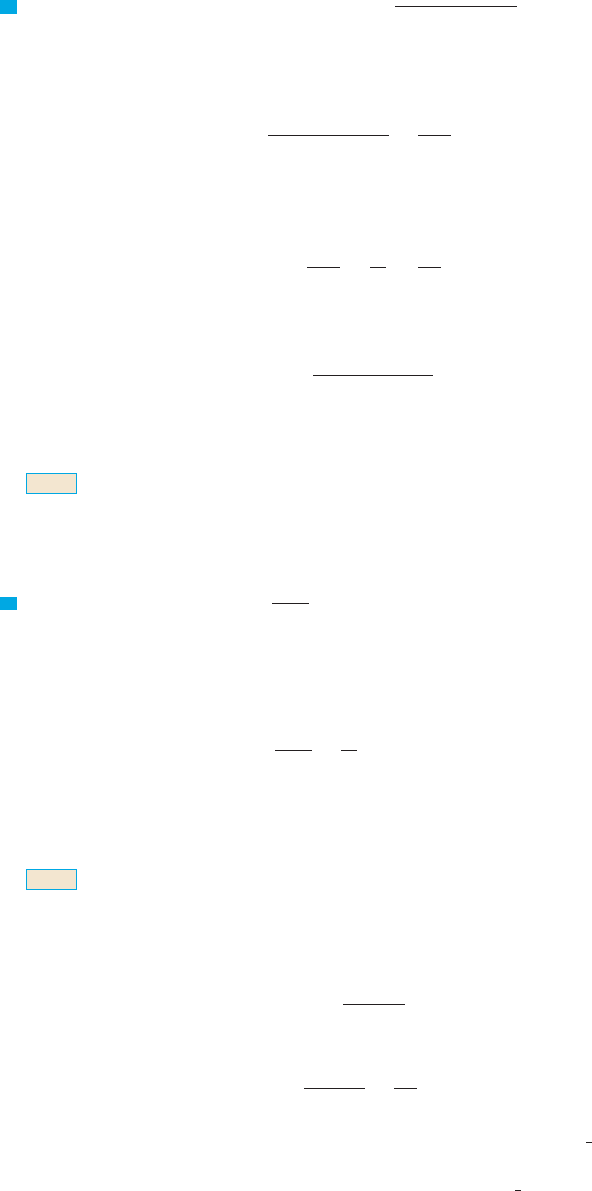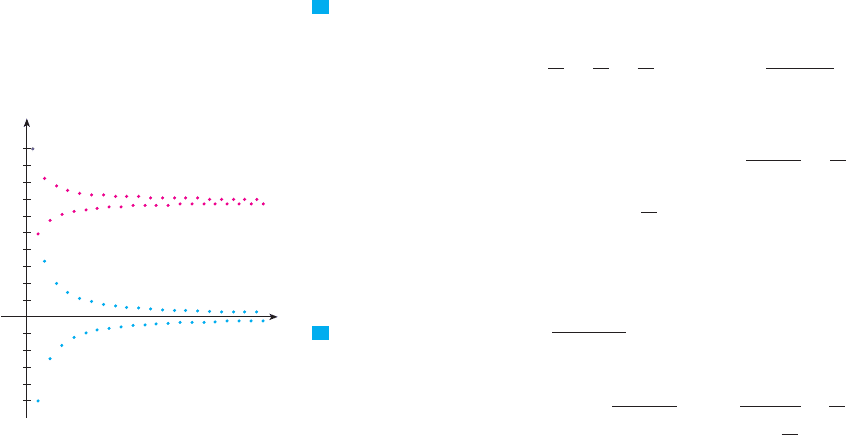Stewart J. Calculus
Подождите немного. Документ загружается.


EXAMPLE 1 Determine whether the series converges or diverges.
SOLUTION For large the dominant term in the denominator is so we compare the
given series with the series . Observe that
because the left side has a bigger denominator. (In the notation of the Comparison Test,
is the left side and is the right side.) We know that
is convergent because it’s a constant times a -series with . Therefore
is convergent by part (i) of the Comparison Test. M
Although the condition or in the Comparison Test is given for
all , we need verify only that it holds for , where is some fixed integer, because
the convergence of a series is not affected by a finite number of terms. This is illustrated
in the next example.
EXAMPLE 2 Test the series for convergence or divergence.
SOLUTION This series was tested (using the Integral Test) in Example 4 in Section 12.3,
but it is also possible to test it by comparing it with the harmonic series. Observe that
for and so
We know that is divergent ( -series with ). Thus the given series is divergent
by the Comparison Test.
M
The terms of the series being tested must be smaller than those of a convergent
series or larger than those of a divergent series. If the terms are larger than the terms of a
convergent series or smaller than those of a divergent series, then the Comparison Test
doesn’t apply. Consider, for instance, the series
The inequality
is useless as far as the Comparison Test is concerned because is convergent
and . Nonetheless, we have the feeling that ought to be convergent
because it is very similar to the convergent geometric series . In such cases the fol-
lowing test can be used.
$
(
1
2
)
n
$
1+(2
n
" 1)a
n
$ b
n
$
b
n
!
$
(
1
2
)
n
1
2
n
" 1
$
1
2
n
!
!
n!1
1
2
n
" 1
NOTE 2
p ! 1p
$
1+n
n ) 3
ln n
n
$
1
n
n ) 3ln n $ 1
!
!
n!1
ln n
n
V
Nn ) Nn
a
n
) b
n
a
n
' b
n
NOTE 1
!
!
n!1
5
2n
2
# 4n # 3
p ! 2 $ 1p
!
!
n!1
5
2n
2
!
5
2
!
!
n!1
1
n
2
b
n
a
n
5
2n
2
# 4n # 3
*
5
2n
2
$
5+(2n
2
)
2n
2
n
!
!
n!1
5
2n
2
# 4n # 3
V
742
|| ||
CHAPTER 12 INFINITE SEQUENCES AND SERIES

THE LIMIT COMPARISON TEST Suppose that and are series with positive
terms. If
where c is a finite number and , then either both series converge or both
diverge.
PROOF Let m and M be positive numbers such that . Because is close
to c for large n, there is an integer N such that
and so
If converges, so does . Thus converges by part (i) of the Comparison
Test. If diverges, so does and part (ii) of the Comparison Test shows that
diverges. M
EXAMPLE 3 Test the series for convergence or divergence.
SOLUTION We use the Limit Comparison Test with
and obtain
Since this limit exists and is a convergent geometric series, the given series con-
verges by the Limit Comparison Test. M
EXAMPLE 4 Determine whether the series converges or diverges.
SOLUTION The dominant part of the numerator is and the dominant part of the denomi-
nator is . This suggests taking
! lim
n
l
!
2 #
3
n
2
.
5
n
5
# 1
!
2 # 0
2
s
0 # 1
! 1
lim
n
l
!
a
n
b
n
! lim
n
l
!
2n
2
# 3n
s
5 # n
5
!
n
1+2
2
! lim
n
l
!
2n
5+2
# 3n
3+2
2
s
5 # n
5
b
n
!
2n
2
n
5+2
!
2
n
1+2
a
n
!
2n
2
# 3n
s
5 # n
5
s
n
5
! n
5+2
2n
2
!
!
n!1
2n
2
# 3n
s
5 # n
5
$
1+2
n
lim
n
l
!
a
n
b
n
! lim
n
l
!
1+(2
n
" 1)
1+2
n
! lim
n
l
!
2
n
2
n
" 1
! lim
n
l
!
1
1 " 1+2
n
! 1 $ 0
b
n
!
1
2
n
a
n
!
1
2
n
" 1
!
!
n!1
1
2
n
" 1
$
a
n
$
mb
n
$
b
n
$
a
n
$
Mb
n
$
b
n
mb
n
*
a
n
*
Mb
n
when n $ N
m
*
a
n
b
n
*
M when n $ N
a
n
+b
n
m
*
c
*
M
c $ 0
lim
n
l
!
a
n
b
n
! c
$
b
n
$
a
n
SECTION 12.4 THE COMPARISON TESTS
|| ||
743
N Exercises 40 and 41 deal with the
cases and .c ! !c ! 0

Since is divergent
(
-series with
)
, the given series diverges
by the Limit Comparison Test. M
Notice that in testing many series we find a suitable comparison series by keeping
only the highest powers in the numerator and denominator.
ESTIMATING SUMS
If we have used the Comparison Test to show that a series converges by comparison
with a series , then we may be able to estimate the sum by comparing remainders.
As in Section 12.3, we consider the remainder
For the comparison series we consider the corresponding remainder
Since for all , we have . If is a -series, we can estimate its remain-
der as in Section 12.3. If is a geometric series, then is the sum of a geometric
series and we can sum it exactly (see Exercises 35 and 36). In either case we know that
is smaller than .
EXAMPLE 5 Use the sum of the first 100 terms to approximate the sum of the series
. Estimate the error involved in this approximation.
SOLUTION Since
the given series is convergent by the Comparison Test. The remainder for the compari-
son series was estimated in Example 5 in Section 12.3 using the Remainder Esti-
mate for the Integral Test. There we found that
Therefore the remainder for the given series satisfies
With we have
Using a programmable calculator or a computer, we find that
with error less than .
M
0.00005
!
!
n!1
1
n
3
# 1
,
!
100
n!1
1
n
3
# 1
, 0.6864538
R
100
'
1
2(100)
2
! 0.00005
n ! 100
R
n
' T
n
'
1
2n
2
R
n
T
n
'
y
!
n
1
x
3
dx !
1
2n
2
$
1+n
3
T
n
1
n
3
# 1
*
1
n
3
$
1+(n
3
# 1)
V
T
n
R
n
T
n
$
b
n
T
n
p
$
b
n
R
n
' T
n
na
n
' b
n
T
n
! t " t
n
! b
n#1
# b
n#2
# & & &
$
b
n
R
n
! s " s
n
! a
n#1
# a
n#2
# & & &
$
a
n
$
b
n
$
a
n
$
b
n
p !
1
2
*
1p
$
b
n
! 2
$
1+n
1+2
744
|| ||
CHAPTER 12 INFINITE SEQUENCES AND SERIES

33 –36 Use the sum of the first 10 terms to approximate the sum of
the series. Estimate the error.
33. 34.
35. 36.
The meaning of the decimal representation of a number
(where the digit is one of the numbers 0, 1,
2, . . . , 9) is that
Show that this series always converges.
38. For what values of does the series converge?
39. Prove that if and converges, then also
converges.
40. (a) Suppose that and are series with positive terms
and is convergent. Prove that if
then is also convergent.
(b) Use part (a) to show that the series converges.
(i)
(ii)
(a) Suppose that and are series with positive terms
and is divergent. Prove that if
then is also divergent.
(b) Use part (a) to show that the series diverges.
(i)
(ii)
42. Give an example of a pair of series and with positive
terms where and diverges, but
converges. (Compare with Exercise 40.)
43. Show that if and then is
divergent.
44. Show that if and is convergent, then
is convergent.
45. If is a convergent series with positive terms, is it true that
is also convergent?
46. If and are both convergent series with positive terms,
is it true that is also convergent?
$
a
n
b
n
$
b
n
$
a
n
$
sin(a
n
)
$
a
n
$
ln(1 # a
n
)
$
a
n
a
n
$ 0
$
a
n
lim
n l !
na
n
" 0, a
n
$ 0
$
a
n
$
b
n
lim
n l !
(a
n
+b
n
) ! 0
$
b
n
$
a
n
!
!
n!1
ln n
n
!
!
n!2
1
ln n
$
a
n
lim
n l !
a
n
b
n
! !
$
b
n
$
b
n
$
a
n
41.
!
!
n!1
ln n
s
n
e
n
!
!
n!1
ln n
n
3
$
a
n
lim
n l !
a
n
b
n
! 0
$
b
n
$
b
n
$
a
n
$
a
n
2
$
a
n
a
n
) 0
$
!
n!2
1+(n
p
ln n)p
0.d
1
d
2
d
3
d
4
. . . !
d
1
10
#
d
2
10
2
#
d
3
10
3
#
d
4
10
4
# & & &
d
i
0.d
1
d
2
d
3
. . .
37.
!
!
n!1
n
(n # 1)3
n
!
!
n!1
1
1 # 2
n
!
!
n!1
sin
2
n
n
3
!
!
n!1
1
s
n
4
# 1
Suppose and are series with positive terms and is
known to be convergent.
(a) If for all , what can you say about ? Why?
(b) If for all , what can you say about ? Why?
2. Suppose and are series with positive terms and is
known to be divergent.
(a) If for all n, what can you say about ? Why?
(b) If for all n, what can you say about ? Why?
3–32 Determine whether the series converges or diverges.
3. 4.
5. 6.
7.
9.
11. 12.
13. 14.
15. 16.
18.
19. 20.
21. 22.
23. 24.
25. 26.
27. 28.
29. 30.
32.
!
!
n!1
1
n
1#1+n
!
!
n!1
sin
"
1
n
#
31.
!
!
n!1
n!
n
n
!
!
n!1
1
n!
!
!
n!1
e
1+n
n
!
!
n!1
"
1 #
1
n
#
2
e
"n
!
!
n!1
n # 5
s
3
n
7
# n
2
!
!
n!1
1 # n # n
2
s
1 # n
2
# n
6
!
!
n!1
n
2
" 5n
n
3
# n # 1
!
!
n!1
5 # 2n
(1 # n
2
)
2
!
!
n!3
n # 2
(n # 1)
3
!
!
n!1
s
n # 2
2n
2
# n # 1
!
!
n!1
n # 4
n
n # 6
n
!
!
n!1
1 # 4
n
1 # 3
n
!
!
n!1
1
2n # 3
!
!
n!1
1
s
n
2
# 1
17.
!
!
n!1
1
s
n
3
# 1
!
!
n!1
2 # ("1)
n
n
s
n
!
!
n!2
s
n
n " 1
!
!
n!1
arctan n
n
1.2
!
!
n! 0
1 # sin n
10
n
!
!
n!1
n " 1
n4
n
!
!
n!1
n
2
" 1
3n
4
# 1
10.
!
!
n!1
cos
2
n
n
2
# 1
!
!
n!1
4 # 3
n
2
n
8.
!
!
n!1
9
n
3 # 10
n
!
!
n!1
n " 1
n
2
s
n
!
!
n!1
n # 1
n
s
n
!
!
n!2
n
3
n
4
" 1
!
!
n!1
n
2n
3
# 1
$
a
n
a
n
*
b
n
$
a
n
a
n
$ b
n
$
b
n
$
b
n
$
a
n
$
a
n
na
n
*
b
n
$
a
n
na
n
$ b
n
$
b
n
$
b
n
$
a
n
1.
E X E R C I S E S
12.4
SECTION 12.4 THE COMPARISON TESTS
|| ||
745

ALTERNATING SERIES
The convergence tests that we have looked at so far apply only to series with positive
terms. In this section and the next we learn how to deal with series whose terms are not
necessarily positive. Of particular importance are alternating series, whose terms alternate
in sign.
An alternating series is a series whose terms are alternately positive and negative. Here
are two examples:
We see from these examples that the th term of an alternating series is of the form
where is a positive number.
(
In fact, .
)
The following test says that if the terms of an alternating series decrease toward 0 in
absolute value, then the series converges.
THE ALTERNATING SERIES TEST If the alternating series
satisfies
(i)
(ii)
then the series is convergent.
Before giving the proof let’s look at Figure 1, which gives a picture of the idea behind
the proof. We first plot on a number line. To find we subtract , so is to the
left of . Then to find we add , so is to the right of . But, since , is to
the left of . Continuing in this manner, we see that the partial sums oscillate back and
forth. Since , the successive steps are becoming smaller and smaller. The even par-
tial sums , , , . . . are increasing and the odd partial sums , , , . . . are decreasing.
Thus it seems plausible that both are converging to some number , which is the sum of
the series. Therefore we consider the even and odd partial sums separately in the follow-
ing proof.
F I G U R E 1
0 s¡
s™ s£s¢ s∞sß
s
b¡
-b™
+b£
-b¢
+b∞
-bß
s
s
5
s
3
s
1
s
6
s
4
s
2
b
n
l 0
s
1
s
3
b
3
*
b
2
s
2
s
3
b
3
s
3
s
1
s
2
b
2
s
2
s
1
! b
1
lim
n l !
b
n
! 0
for all nb
n#1
' b
n
b
n
$ 0
!
!
n!1
("1)
n"1
b
n
! b
1
" b
2
# b
3
" b
4
# b
5
" b
6
# & & &
b
n
!
-
a
n
-
b
n
a
n
! ("1)
n
b
n
ora
n
! ("1)
n"1
b
n
n
"
1
2
#
2
3
"
3
4
#
4
5
"
5
6
#
6
7
" & & & !
!
!
n!1
("1)
n
n
n # 1
1 "
1
2
#
1
3
"
1
4
#
1
5
"
1
6
# & & & !
!
!
n!1
("1)
n"1
n
12.5
746
|| ||
CHAPTER 12 INFINITE SEQUENCES AND SERIES

PROOF OF THE ALTERNATING SERIES TEST We first consider the even partial sums:
In general
Thus
But we can also write
Every term in brackets is positive, so for all . Therefore the sequence
of even partial sums is increasing and bounded above. It is therefore convergent by the
Monotonic Sequence Theorem. Let’s call its limit , that is,
Now we compute the limit of the odd partial sums:
[by condition (ii)]
Since both the even and odd partial sums converge to , we have
[see Exercise 80(a) in Section 12.1] and so the series is convergent.
M
EXAMPLE 1 The alternating harmonic series
satisfies
(i) because
(ii)
so the series is convergent by the Alternating Series Test.
M
EXAMPLE 2 The series is alternating but
lim
n
l
!
b
n
! lim
n
l
!
3n
4n " 1
! lim
n
l
!
3
4 "
1
n
!
3
4
!
!
n!1
("1)
n
3n
4n " 1
V
lim
n l !
b
n
! lim
n l !
1
n
! 0
1
n # 1
*
1
n
b
n#1
*
b
n
1 "
1
2
#
1
3
"
1
4
# & & & !
!
!
n!1
("1)
n"1
n
V
lim
n l !
s
n
! ss
! s
! s # 0
! lim
n l !
s
2n
# lim
n l !
b
2n#1
lim
n l !
s
2n#1
! lim
n l !
(s
2n
# b
2n#1
)
lim
n l !
s
2n
! s
s
%s
2n
&ns
2n
' b
1
s
2n
! b
1
" (b
2
" b
3
) " (b
4
" b
5
) " & & & " (b
2n"2
" b
2n"1
) " b
2n
0 ' s
2
' s
4
' s
6
' & & & ' s
2n
' & & &
since b
2n
' b
2n"1
s
2n
! s
2n"2
# (b
2n"1
" b
2n
) ) s
2n"2
since b
4
' b
3
s
4
! s
2
# (b
3
" b
4
) ) s
2
since b
2
' b
1
s
2
! b
1
" b
2
) 0
SECTION 12.5 ALTERNATING SERIES
|| ||
747
F I G U R E 2
0
n
1
%a
n
&
%s
n
&
N Figure 2 illustrates Example 1 by showing the
graphs of the terms and the
partial sums . Notice how the values of
zigzag across the limiting value, which appears
to be about . In fact, it can be proved that
the exact sum of the series is
(see Exercise 36).
ln 2 , 0.693
0.7
s
n
s
n
a
n
! ("1)
n"1
+n

so condition (ii) is not satisfied. Instead, we look at the limit of the nth term of the series:
This limit does not exist, so the series diverges by the Test for Divergence.
M
EXAMPLE 3 Test the series for convergence or divergence.
SOLUTION The given series is alternating so we try to verify conditions (i) and (ii) of the
Alternating Series Test.
Unlike the situation in Example 1, it is not obvious that the sequence given by
is decreasing. However, if we consider the related function
, we find that
Since we are considering only positive , we see that if , that is,
. Thus is decreasing on the interval
.
This means that
and therefore when . (The inequality can be verified directly but
all that really matters is that the sequence is eventually decreasing.)
Condition (ii) is readily verified:
Thus the given series is convergent by the Alternating Series Test.
M
ESTIMATING SUMS
A partial sum of any convergent series can be used as an approximation to the total sum
, but this is not of much use unless we can estimate the accuracy of the approximation. The
error involved in using is the remainder . The next theorem says that
for series that satisfy the conditions of the Alternating Series Test, the size of the error is
smaller than , which is the absolute value of the first neglected term.
ALTERNATING SERIES ESTIMATION THEOREM If is the sum of an
alternating series that satisfies
(i) and (ii)
then
PROOF We know from the proof of the Alternating Series Test that s lies between any two
consecutive partial sums and . It follows that
M
-
s " s
n
-
'
-
s
n#1
" s
n
-
! b
n#1
s
n#1
s
n
-
R
n
-
!
-
s " s
n
-
' b
n#1
lim
n l !
b
n
! 00 ' b
n#1
' b
n
s !
$
("1)
n"1
b
n
b
n#1
R
n
! s " s
n
s , s
n
s
s
n
lim
n
l
!
b
n
! lim
n
l
!
n
2
n
3
# 1
! lim
n
l
!
1
n
1 #
1
n
3
! 0
%b
n
&
b
2
*
b
1
n ) 2b
n#1
*
b
n
f (n # 1)
*
f (n)
(
s
3
2
, !
)
fx $
s
3
2
2 " x
3
*
0f +(x)
*
0x
f +(x) !
x(2 " x
3
)
(x
3
# 1)
2
f (x) ! x
2
+(x
3
# 1)
b
n
! n
2
+(n
3
# 1)
!
!
n!1
("1)
n#1
n
2
n
3
# 1
lim
n
l
!
a
n
! lim
n
l
!
("1)
n
3n
4n " 1
748
|| ||
CHAPTER 12 INFINITE SEQUENCES AND SERIES
N Instead of verifying condition (i) of the Alter-
nating Series Test by computing a derivative,
we could verify that directly by using
the technique of Solution 1 of Example 12 in
Section 12.1.
b
n#1
*
b
n
N You can see geometrically why the
Alternating Series Estimation Theorem is true
by looking at Figure 1 (on page 746). Notice that
and so on. Notice
also that lies between any two consecutive
partial sums.
s
-
s " s
5
-
*
b
6
,s " s
4
*
b
5
,

EXAMPLE 4 Find the sum of the series correct to three decimal places.
(By definition, .)
SOLUTION We first observe that the series is convergent by the Alternating Series Test
because
(i)
(ii) so as
To get a feel for how many terms we need to use in our approximation, let’s write out
the first few terms of the series:
Notice that
and
By the Alternating Series Estimation Theorem we know that
This error of less than does not affect the third decimal place, so we have
correct to three decimal places. M
|
The rule that the error (in using to approximate ) is smaller than the first
neglected term is, in general, valid only for alternating series that satisfy the conditions
of the Alternating Series Estimation Theorem. The rule does not apply to other types of
series.
ss
n
NOTE
s , 0.368
0.0002
-
s " s
6
-
' b
7
*
0.0002
s
6
! 1 " 1 #
1
2
"
1
6
#
1
24
"
1
120
#
1
720
, 0.368056
b
7
!
1
5040
*
1
5000
! 0.0002
! 1 " 1 #
1
2
"
1
6
#
1
24
"
1
120
#
1
720
"
1
5040
# & & &
s !
1
0!
"
1
1!
#
1
2!
"
1
3!
#
1
4!
"
1
5!
#
1
6!
"
1
7!
# & & &
n l !
1
n!
l 00
*
1
n!
*
1
n
l 0
1
(n # 1)!
!
1
n! (n # 1)
*
1
n!
0! ! 1
!
!
n!0
("1)
n
n!
V
SECTION 12.5 ALTERNATING SERIES
|| ||
749
N In Section 12.10 we will prove that
for all , so what we have
obtained in Example 4 is actually an approxi-
mation to the number .e
"1
xe
x
!
$
!
n!0
x
n
+n!
9. 10.
12.
14.
15. 16.
18.
19. 20.
!
!
n!1
"
"
n
5
#
n
!
!
n!1
("1)
n
n
n
n!
!
!
n!1
("1)
n
cos
"
,
n
#
!
!
n!1
("1)
n
sin
"
,
n
#
17.
!
!
n!1
sin(n
,
+2)
n!
!
!
n!1
cos n
,
n
3+4
!
!
n!1
("1)
n"1
ln n
n
!
!
n!2
("1)
n
n
ln n
13.
!
!
n!1
("1)
n"1
e
1+n
n
!
!
n!1
("1)
n#1
n
2
n
3
# 4
11.
!
!
n!1
("1)
n
s
n
1 # 2
s
n
!
!
n!1
("1)
n
n
10
n
1. (a) What is an alternating series?
(b) Under what conditions does an alternating series converge?
(c) If these conditions are satisfied, what can you say about the
remainder after terms?
2–20 Test the series for convergence or divergence.
2.
4.
5. 6.
8.
!
!
n!1
("1)
n
n
s
n
3
# 2
!
!
n!1
("1)
n
3n " 1
2n # 1
7.
!
!
n!1
("1)
n"1
ln(n # 4)
!
!
n!1
("1)
n"1
2n # 1
1
s
2
"
1
s
3
#
1
s
4
"
1
s
5
#
1
s
6
" & & &
4
7
"
4
8
#
4
9
"
4
10
#
4
11
" & & &
3.
"
1
3
#
2
4
"
3
5
#
4
6
"
5
7
# & & &
n
E X E R C I S E S
12.5

31. Is the 50th partial sum of the alternating series
an overestimate or an underestimate of the
total sum? Explain.
32–34 For what values of is each series convergent?
33. 34.
35. Show that the series , where if is odd
and if is even, is divergent. Why does the Alter-
nating Series Test not apply?
36. Use the following steps to show that
Let and be the partial sums of the harmonic and alter-
nating harmonic series.
(a) Show that .
(b) From Exercise 40 in Section 12.3 we have
as
and therefore
as
Use these facts together with part (a) to show that
as .n l !s
2n
l ln 2
n l !h
2n
" ln!2n" l
#
n l !h
n
" ln n l
#
s
2n
! h
2n
" h
n
s
n
h
n
#
!
n!1
!"1"
n"1
n
! ln 2
nb
n
! 1$n
2
nb
n
! 1$n
%
!"1"
n"1
b
n
#
!
n!2
!"1"
n"1
!ln n"
p
n
#
!
n!1
!"1"
n
n $ p
#
!
n!1
!"1"
n"1
n
p
32.
p
%
!
n!1
!"1"
n"1
$n
s
50
;
21–22 Calculate the first 10 partial sums of the series and graph
both the sequence of terms and the sequence of partial sums on
the same screen. Estimate the error in using the 10th partial sum
to approximate the total sum.
21. 22.
23–26 Show that the series is convergent. How many terms of
the series do we need to add in order to find the sum to the indi-
cated accuracy?
24.
25.
26.
27–30 Approximate the sum of the series correct to four
decimal places.
27. 28.
29. 30.
#
!
n!1
!"1"
n
3
n
n!
#
!
n!1
!"1"
n"1
n
2
10
n
#
!
n!1
!"1"
n
n
8
n
#
!
n!1
!"1"
n$1
n
5
(
&
error
&
%
0.01
)
#
!
n!1
!"1"
n"1
ne
"n
(
&
error
&
%
0.000005
)
#
!
n!0
!"1"
n
10
n
n!
(
&
error
&
%
0.0001
)
#
!
n!1
!"1"
n
n 5
n
(
&
error
&
%
0.00005
)
#
!
n!1
!"1"
n$1
n
6
23.
#
!
n!1
!"1"
n"1
n
3
#
!
n!1
!"1"
n"1
n
3$2
750
|| ||
CHAPTER 12 INFINITE SEQUENCES AND SERIES
ABSOLUTE CONVERGENCE AND THE RATIO AND ROOT TESTS
Given any series , we can consider the corresponding series
whose terms are the absolute values of the terms of the original series.
DEFINITION A series is called absolutely convergent if the series of
absolute values is convergent.
Notice that if is a series with positive terms, then and so absolute con-
vergence is the same as convergence in this case.
EXAMPLE 1 The series
#
!
n!1
!"1"
n"1
n
2
! 1 "
1
2
2
$
1
3
2
"
1
4
2
$ & & &
&
a
n
&
! a
n
%
a
n
%
&
a
n
&
%
a
n
1
#
!
n!1
&
a
n
&
!
&
a
1
&
$
&
a
2
&
$
&
a
3
&
$ & & &
%
a
n
12.6
N We have convergence tests for series with
positive terms and for alternating series. But
what if the signs of the terms switch back and
forth irregularly? We will see in Example 3 that
the idea of absolute convergence sometimes
helps in such cases.

is absolutely convergent because
is a convergent -series ( ).
M
EXAMPLE 2 We know that the alternating harmonic series
is convergent (see Example 1 in Section 12.5), but it is not absolutely convergent
because the corresponding series of absolute values is
which is the harmonic series ( -series with ) and is therefore divergent.
M
DEFINITION A series is called conditionally convergent if it is conver-
gent but not absolutely convergent.
Example 2 shows that the alternating harmonic series is conditionally convergent. Thus
it is possible for a series to be convergent but not absolutely convergent. However, the next
theorem shows that absolute convergence implies convergence.
THEOREM If a series is absolutely convergent, then it is convergent.
PROOF Observe that the inequality
is true because is either or . If is absolutely convergent, then is
convergent, so is convergent. Therefore, by the Comparison Test,
is convergent. Then
is the difference of two convergent series and is therefore convergent.
M
EXAMPLE 3 Determine whether the series
is convergent or divergent.
SOLUTION This series has both positive and negative terms, but it is not alternating.
(The first term is positive, the next three are negative, and the following three are posi-
tive: The signs change irregularly.) We can apply the Comparison Test to the series of
absolute values
#
!
n!1
'
cos n
n
2
'
!
#
!
n!1
&
cos n
&
n
2
#
!
n!1
cos n
n
2
!
cos 1
1
2
$
cos 2
2
2
$
cos 3
3
2
$ & & &
V
#
a
n
!
#
(
a
n
$
&
a
n
&
)
"
#
&
a
n
&
%
(
a
n
$
&
a
n
&
)
%
2
&
a
n
&
%
&
a
n
&
%
a
n
"a
n
a
n
&
a
n
&
0 ' a
n
$
&
a
n
&
' 2
&
a
n
&
%
a
n
3
%
a
n
2
p ! 1p
#
!
n!1
'
!"1"
n"1
n
'
!
#
!
n!1
1
n
! 1 $
1
2
$
1
3
$
1
4
$ & & &
#
!
n!1
!"1"
n"1
n
! 1 "
1
2
$
1
3
"
1
4
$ & & &
p ! 2p
#
!
n!1
'
!"1"
n"1
n
2
'
!
#
!
n!1
1
n
2
! 1 $
1
2
2
$
1
3
2
$
1
4
2
$ & & &
SECTION 12.6 ABSOLUTE CONVERGENCE AND THE RATIO AND ROOT TESTS
|| ||
751
F I G U R E 1
0
n
0.5
(a
n
)
(s
n
)
N Figure 1 shows the graphs of the terms and
partial sums of the series in Example 3. Notice
that the series is not alternating but has positive
and negative terms.
s
n
a
n
